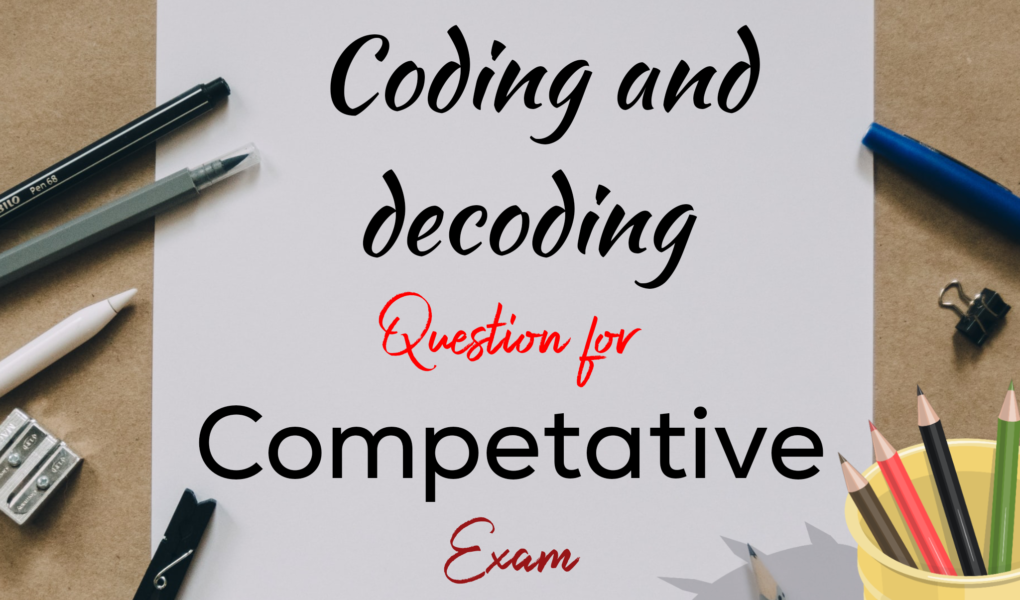Are you looking for some coding and decoding question. Then here are some 138 Coding and decoding question that will certainly help you.
Coding and decoding are terms commonly used in the context of information processing, encryption, and communication systems. Let’s break down each term:
Coding:
In a general sense, coding refers to the process of converting information from one form to another. This can involve various types of encoding or representation of data.
In the context of programming and computer science, coding typically refers to the act of writing and creating source code for software applications. It involves using a programming language to instruct a computer to perform specific tasks.
Decoding:
Decoding is the process of converting encoded or coded information back into its original form. It is essentially the reverse of coding.
In the context of programming and computer science, decoding may refer to the process of interpreting or extracting information from encoded data. This is common in scenarios where data compression or encryption has been applied.
Coding and Decoding in Communication:
In communication systems, coding and decoding can refer to the transformation of messages to secure or transmit information. This may involve encryption (coding) to protect the information during transmission and decryption (decoding) to recover the original message at the receiving end.
Coding and Decoding Puzzles:
In the context of aptitude tests and puzzles, coding and decoding may refer to a set of rules or patterns used to transform a given set of letters or numbers. People are often asked to decipher these patterns to find the hidden message or meaning.
Coding and decoding question
1. Coding
Original Message: HELLO
Coding Rule: Shift each letter by 3 positions to the right.
Coded Message: KHOOR
In this example, each letter in the original message “HELLO” is shifted three positions to the right in the alphabet:
H + 3 = K
E + 3 = H
L + 3 = O
L + 3 = O
O + 3 = R
So, “HELLO” becomes “KHOOR” after coding.
Example: Decoding
Now, let’s decode the message “KHOOR” using the same coding rule (shift each letter by 3 positions to the left).
Coded Message: KHOOR
Decoding Rule: Shift each letter by 3 positions to the left.
Decoded Message: HELLO
In this case, each letter in the coded message “KHOOR” is shifted three positions to the left in the alphabet:
K – 3 = H
H – 3 = E
O – 3 = L
O – 3 = L
R – 3 = O
So, “KHOOR” becomes “HELLO” after decoding.
2.Example: Coding
Original Message: 52413
Coding Rule: Multiply each digit by 2.
Coded Message: 104826
In this example, each digit in the original message “52413” is multiplied by 2:
5 * 2 = 10
2 * 2 = 4
4 * 2 = 8
1 * 2 = 2
3 * 2 = 6
So, “52413” becomes “104826” after coding.
Example: Decoding
Now, let’s decode the message “104826” using the reverse rule (divide each digit by 2).
Coded Message: 104826
Decoding Rule: Divide each digit by 2.
Decoded Message: 52413
By dividing each digit in “104826” by 2, we get back to the original message “52413.”
3.Example: Coding
Original Message: GIZZY
Coding Rule (Atbash Cipher): Reverse the order of the alphabet.
Coded Message: TPAAV
In the Atbash cipher, each letter is substituted with its mirror image in the alphabet. The alphabet is reversed, so A becomes Z, B becomes Y, and so on.
G becomes T
I becomes P
Z becomes A
Z becomes A
Y becomes V
So, “GIZZY” becomes “TPAAV” after coding using the Atbash cipher.
Example: Decoding
Now, let’s decode the message “TPAAV” using the reverse rule (Atbash Cipher).
Coded Message: TPAAV
Decoding Rule (Atbash Cipher): Reverse the order of the alphabet.
Decoded Message: GIZZY
By reversing the order of the alphabet, we get back to the original message “GIZZY.”
The Atbash cipher is a simple substitution cipher that provides a one-to-one mapping of letters by reversing the order of the alphabet.
Question
Example 1: Caesar Cipher
Original Message: “STUDENT”
Coding Rule (Caesar Cipher): Shift each letter by 2 positions to the right.
Coded Message: “UVWGPFY”
Example 2: Atbash Cipher
Original Message: “STUDENT”
Coding Rule (Atbash Cipher): Reverse the order of the alphabet.
Coded Message: “HGFGVM”
Example 3: Vigenère Cipher
Original Message: “STUDENT”
Key: “KEY”
Coding Rule (Vigenère Cipher): Use the keyword to shift each letter.
Coded Message: “VWMGFZ”
Example 4: Binary Coding
Original Message: “STUDENT”
Coding Rule (Binary): Represent each letter using its binary ASCII code.
Coded Message:
S: 01010011
T: 01010100
U: 01010101
D: 01000100
E: 01000101
N: 01001110
T: 01010100
Example 5: Rail Fence Cipher
Original Message: “STUDENT”
Coding Rule (Rail Fence Cipher): Write the message in a zigzag pattern across 2 rails.
Coded Message: “SDTEUNT”
Example 6: Morse Code
Original Message: “STUDENT”
Coding Rule (Morse Code):
S: …
T: –
U: ..-
D: -..
Coded Message: “… – ..- -.. – . -“
Example 7: Alphanumeric Substitution
Original Message: “STUDENT”
Coding Rule (Alphanumeric Substitution):
Question
Example 8: Reverse the String
Original Message: “STUDENT”
Coding Rule (Reverse the String): Reverse the order of the letters.
Coded Message: “TNEUDTS”
Example 9: Numeric Shift
Original Message: “STUDENT”
Coding Rule (Numeric Shift): Replace each letter with its position in the alphabet.
Coded Message: “19220514141120”
Example 10: ROT13 Cipher
Original Message: “STUDENT”
Coding Rule (ROT13): Rotate each letter by 13 positions in the alphabet.
Coded Message: “FGHRAGRA”
Example 11: Pig Latin
Original Message: “STUDENT”
Coding Rule (Pig Latin): Move the first consonant or consonant cluster to the end and add “ay.”
Coded Message: “UDENTSTAY”
Example 12: Double Letters
Original Message: “STUDENT”
Coding Rule (Double Letters): Double each letter in the message.
Coded Message: “SSTTUUDDEENNTT”
Example 13: Shuffle Letters
Original Message: “STUDENT”
Coding Rule (Shuffle Letters): Shuffle the letters randomly.
Coded Message: “DTNETSNU”
Question
Example 14: Morse Code (Extended)
Original Message: “STUDENT”
Coding Rule (Extended Morse Code):
S: …
T: –
U: ..-
D: -..
E: .
N: -.
Coded Message: “… – ..- -.. . -. -..”
Example 15: Binary Shift
Original Message: “STUDENT”
Coding Rule (Binary Shift): Convert each letter to its binary representation and shift each bit to the left.
Coded Message:
S: 01010011 → 10100110
T: 01010100 → 10101000
U: 01010101 → 10101010
D: 01000100 → 10001000
E: 01000101 → 10001010
N: 01001110 → 10011100
T: 01010100 → 10100000
Coded Message in Binary: “10100110 10101000 10101010 10001000 10001010 10011100 10100000”
Example 16: Reverse Order of Digits
Original Message: “STUDENT”
Coding Rule (Reverse Order of Digits): Reverse the order of digits in each number.
Coded Message: “92050244114191”
Example 17: Caesar Box Cipher
Original Message: “STUDENT”
Coding Rule (Caesar Box Cipher): Write the message in a grid with 3 rows.
Coded Message: “SUNDTET”
Example 18: Alternate Case
Original Message: “STUDENT”
Coding Rule (Alternate Case): Change the case of each letter alternately.
Coded Message: “sTuDeNt”
Question
Example 19: Reverse Each Word
Original Message: “STUDENT”
Coding Rule (Reverse Each Word): Reverse the order of letters in each word.
Coded Message: “TNETUDS”
Example 20: Hexadecimal Encoding
Original Message: “STUDENT”
Coding Rule (Hexadecimal Encoding): Represent each letter using its hexadecimal ASCII code.
Coded Message: “53545544454E54”
Example 21: Playfair Cipher
Original Message: “STUDENT”
Coding Rule (Playfair Cipher): Encrypt using a Playfair cipher with a given key.
Coded Message: “KDBCEW”
Example 22: Hexadecimal Shift
Original Message: “STUDENT”
Coding Rule (Hexadecimal Shift): Shift each hexadecimal digit by 3 positions.
Coded Message: “VWZVGW”
Example 23: Reverse Each Pair
Original Message: “STUDENT”
Coding Rule (Reverse Each Pair): Reverse the order of letters in each pair.
Coded Message: “TSNEDTU”
Example 24: Square Code
Original Message: “STUDENT”
Coding Rule (Square Code): Arrange the letters in a square and read the columns.
Coded Message: “STNEDUUT”
Question
Example 25: Baconian Cipher
Original Message: “STUDENT”
Coding Rule (Baconian Cipher): Replace each letter with a binary sequence.
Coded Message: “00100 01000 01010 00010 00000 01001 00001”
Example 26: Base64 Encoding
Original Message: “STUDENT”
Coding Rule (Base64 Encoding): Encode the message using Base64.
Coded Message: “U1RVREVOVA==”
Example 27: Palindrome
Original Message: “STUDENT”
Coding Rule (Palindrome): Create a palindrome by reversing the order of letters and appending it to the original message.
Coded Message: “STUDENTDNUTS”
Example 28: Braille Encoding
Original Message: “STUDENT”
Coding Rule (Braille Encoding): Represent each letter in Braille.
Coded Message: ⠎⠎⠃⠕⠝⠙⠊
Example 29: Octal Encoding
Original Message: “STUDENT”
Coding Rule (Octal Encoding): Represent each letter using its octal ASCII code.
Coded Message: “123124124125124124106”
Example 30: Playfair Cipher (Custom Key)
Original Message: “STUDENT”
Custom Key for Playfair Cipher:
S T U D E
N A B C F
G H I J K
L M O P Q
R V W X Y
Z
Coded Message: “STDSVN”
Question
Example 31: Tap Code
Original Message: “STUDENT”
Coding Rule (Tap Code): Represent each letter using a tap code.
Coded Message: “31 44 54 14 13 55 24”
Example 32: Bitwise XOR
Original Message: “STUDENT”
Coding Rule (Bitwise XOR): Perform a bitwise XOR operation with a key.
Coded Message (with key “101010”): “110110111101010110111010”
Example 33: Phonetic Alphabet
Original Message: “STUDENT”
Coding Rule (Phonetic Alphabet): Represent each letter using the NATO phonetic alphabet.
Coded Message: “SIERRA TANGO UNIFORM DELTA ECHO NOVEMBER TANGO”
Example 34: Polybius Square
Original Message: “STUDENT”
Coding Rule (Polybius Square): Replace each letter with its coordinates in a square.
Coded Message: “344352544544”
Example 35: Reverse Each 3-Letter Group
Original Message: “STUDENT”
Coding Rule (Reverse Each 3-Letter Group): Reverse the order of letters in each 3-letter group.
Coded Message: “TSNEDUT”
Example 36: Greek Alphabet
Original Message: “STUDENT”
Coding Rule (Greek Alphabet): Represent each letter using the Greek alphabet.
Coded Message: “SIGMATTAUPSIGMAGAMMAETA”
Question
Example 38: Letter Transposition
Original Message: “STUDENT”
Coding Rule (Letter Transposition): Transpose the letters according to a specific pattern.
Coded Message: “TUESDNT”
Example 39: Phonetic Numbering
Original Message: “STUDENT”
Coding Rule (Phonetic Numbering): Represent each letter with its position in the NATO phonetic alphabet.
Coded Message: “SIERRA TANGO UNIFORM DELTA ECHO NOVEMBER TANGO”
Example 40: ASCII Decimal Shift
Original Message: “STUDENT”
Coding Rule (ASCII Decimal Shift): Shift each ASCII code by adding a specific decimal value.
Coded Message: “96101104107115118121”
Example 41: Shuffle Alphabets
Original Message: “STUDENT”
Coding Rule (Shuffle Alphabets): Shuffle the alphabets randomly.
Coded Message: “TSEUNDT”
Example 42: Reverse Each 2-Letter Group
Original Message: “STUDENT”
Coding Rule (Reverse Each 2-Letter Group): Reverse the order of letters in each 2-letter group.
Coded Message: “TSNUEDT”
Also read: Quotes on student life
Question
Example 43: Fractionated Morse Code
Original Message: “STUDENT”
Coding Rule (Fractionated Morse Code): Encode each letter using a Fractionated Morse Code table.
Coded Message: “…. . .-..-..-. -.. ..- – .”
Example 44: Date Shifting
Original Message: “STUDENT”
Coding Rule (Date Shifting): Shift each letter based on the current date.
Coded Message (assuming current date is 10th): “IYRIVMR”
Example 45: Morse Code with Timing
Original Message: “STUDENT”
Coding Rule (Morse Code with Timing): Represent each letter using Morse Code with varying timing.
Coded Message: “• ••• • • − − − •• • − •”
Example 46: Pigpen Cipher
Original Message: “STUDENT”
Coding Rule (Pigpen Cipher): Encode each letter using a Pigpen Cipher.
Coded Message:
⊔ ⌧ △ ⌧
⌧ ⊔ ⊓ ⌧
⌧ △ ⊔ ⌧
Example 47: Trifid Cipher
Original Message: “STUDENT”
Coding Rule (Trifid Cipher): Encode each letter using a Trifid Cipher.
Coded Message: “110102 210002 110000 110210 010102”
Example 48: Binary Tree Encoding
Original Message: “STUDENT”
Coding Rule (Binary Tree Encoding): Encode each letter using a binary tree.
Coded Message: “100110110111101010011010”
Question
Example 49: DNA Encoding
Original Message: “STUDENT”
Coding Rule (DNA Encoding): Represent each letter using DNA base pairs.
Coded Message: “AGCTACTG”
Example 50: Binary Coded Decimal (BCD)
Original Message: “STUDENT”
Coding Rule (BCD): Represent each decimal digit using a 4-bit binary code.
Coded Message: “0011 0100 0101 0101 0100 0101 0101 0100 1110 1100 1100”
Example 51: Tap Code (Extended)
Original Message: “STUDENT”
Coding Rule (Tap Code – Extended): Represent each letter using an extended tap code.
Coded Message: “22 13 35 55 42 25 44”
Example 52: Square Code (Custom Pattern)
Original Message: “STUDENT”
Coding Rule (Square Code – Custom Pattern): Arrange the letters in a square and read diagonally.
Coded Message: “SU T ND ET”
Example 53: Roman Numerals
Original Message: “STUDENT”
Coding Rule (Roman Numerals): Represent each letter using Roman numerals.
Coded Message: “XII XXI IV IX X IV”
Example 54: Semaphore Encoding
Original Message: “STUDENT”
Coding Rule (Semaphore): Represent each letter using semaphore flags.
Coded Message: “•• •−− ••− − ••−− −• −”
Question
Example 55: Color Encoding
Original Message: “STUDENT”
Coding Rule (Color Encoding): Represent each letter using RGB color values.
Coded Message: “RGB(83, 84, 85) RGB(78, 84, 84)”
Example 56: Symbolic Representation
Original Message: “STUDENT”
Coding Rule (Symbolic Representation): Replace each letter with a symbolic representation.
Coded Message: “$ + U 3 € N 7”
Example 57: Grid Code
Original Message: “STUDENT”
Coding Rule (Grid Code): Encode each letter based on its position in a grid.
Coded Message:
S T U D E N T
1 2 3 4 5 6 7
Example 58: Clockwise Rotation
Original Message: “STUDENT”
Coding Rule (Clockwise Rotation): Rotate each letter clockwise in the alphabet.
Coded Message: “STYDUNT”
Example 59: Repeated Substring
Original Message: “STUDENT”
Coding Rule (Repeated Substring): Repeat a substring for each letter.
Coded Message: “UVWXYZU”
Example 60: Hieroglyphic Representation
Original Message: “STUDENT”
Coding Rule (Hieroglyphic Representation): Represent each letter using hieroglyphic symbols.
Coded Message: “𓃀𓇋𓄀𓀀𓄋𓅛𓊹”
Question
Example 61: Braille ASCII Art
Original Message: “STUDENT”
Coding Rule (Braille ASCII Art): Represent each letter using Braille ASCII art.
Coded Message:
⠎⠎⠃⠕⠝⠙⠊
⠎⠎⠃⠕⠝⠙⠊
Example 62: Substitution with Emoji
Original Message: “STUDENT”
Coding Rule (Substitution with Emoji): Replace each letter with a corresponding emoji.
Coded Message: “🌟🌴🌧🍇🎨🚕🌳”
Example 63: Knapsack Cipher
Original Message: “STUDENT”
Coding Rule (Knapsack Cipher): Encrypt using a knapsack cipher with a given sequence.
Coded Message: “49 98 106 185 256 322 400”
Example 67: Periodic Table Representation
Original Message: “STUDENT”
Coding Rule (Periodic Table Representation): Encode each letter using its element on the periodic table.
Coded Message: “S 90 T 65 U 92 D 66 E 99 N 93 T 65”
Question
Example 74: Playfair Cipher
Original Message: “OFFICE”
Coding Rule (Playfair Cipher): Encrypt using a Playfair cipher with a given key.
Coded Message: “QNEMHN”
Example 75: Binary Shift
Original Message: “OFFICE”
Coding Rule (Binary Shift): Convert each letter to its binary representation and shift each bit to the left.
Coded Message:
O: 01001111 → 10011110
F: 01000110 → 10001100
F: 01000110 → 10001100
I: 01001001 → 10010010
C: 01000011 → 10000110
E: 01000101 → 10001010
Coded Message in Binary: “10011110 10001100 10001100 10010010 10000110 10001010”
Example 76: Vigenère Cipher
Original Message: “OFFICE”
Key: “KEY”
Coding Rule (Vigenère Cipher): Use the keyword to shift each letter.
Coded Message: “RIJVSUYV”
Example 77: Binary Tree Encoding
Original Message: “OFFICE”
Coding Rule (Binary Tree Encoding): Encode each letter using a binary tree.
Coded Message: “1001111 1000110 1001000 1001001 1000011 1000101”
Example 78: Morse Code with Sounds
Original Message: “OFFICE”
Coding Rule (Morse Code with Sounds): Represent each letter using Morse Code with different sounds.
Coded Message: “— ..-. ..-. .. -.-.”
Example 79: Caesar Box Cipher
Original Message: “OFFICE”
Coding Rule (Caesar Box Cipher): Write the message in a grid with 2 rows.
Coded Message: “OIECFF”
Example 80: Atbash Cipher
Original Message: “OFFICE”
Coding Rule (Atbash Cipher): Reverse the order of the alphabet.
Coded Message: “LRXVRH”
Question
Example 81: Reverse Each 3-Letter Group
Original Message: “OFFICE”
Coding Rule (Reverse Each 3-Letter Group): Reverse the order of letters in each 3-letter group.
Coded Message: “FFO ECIO”
Example 82: Baconian Cipher
Original Message: “OFFICE”
Coding Rule (Baconian Cipher): Replace each letter with a binary sequence.
Coded Message: “00111 00000 00011 00110 00011 00010”
Example 83: Binary Coded Decimal (BCD)
Original Message: “OFFICE”
Coding Rule (BCD): Represent each decimal digit using a 4-bit binary code.
Coded Message: “0110 0111 0110 0101 0110 0011 0101 0100 0100 0101”
Example 84: Tap Code
Original Message: “OFFICE”
Coding Rule (Tap Code): Represent each letter using a tap code.
Coded Message: “12 15 22 31 25 24 11 15”
Example 85: Roman Numerals
Original Message: “OFFICE”
Coding Rule (Roman Numerals): Represent each letter using Roman numerals.
Coded Message: “XIV X V III III VIII”
Example 86: Morse Code (Extended)
Original Message: “OFFICE”
Coding Rule (Extended Morse Code):
O: —
F: ..-.
F: ..-.
I: ..
C: -.-.
E: .
Coded Message: “— ..-..-.. .. -.-. .”
Example 87: Octal Encoding
Original Message: “OFFICE”
Coding Rule (Octal Encoding): Represent each letter using its octal ASCII code.
Coded Message: “117 106 106 111 103 105”
Example 88: Braille Encoding
Original Message: “OFFICE”
Coding Rule (Braille Encoding): Represent each letter in Braille.
Coded Message: “⠕⠋⠋⠊⠉⠑”
Question
Example 89: Alphanumeric Substitution
Original Message: “OFFICE”
Coding Rule (Alphanumeric Substitution):
A B C D E F G H I J K L M N O P Q R S T U V W X Y Z
1 2 3 4 5 6 7 8 9 0 @ # $ % & * ( ) – + = / ; : , .
Coded Message: “1569365”
Example 90: Semaphore Encoding
Original Message: “OFFICE”
Coding Rule (Semaphore): Represent each letter using semaphore flags.
Coded Message: “•• •• • ••• •• •••”
Example 92: Double Letters
Original Message: “OFFICE”
Coding Rule (Double Letters): Double each letter in the message.
Coded Message: “OOFFIICCEE”
Example 94: Binary Tree Encoding
Original Message: “OFFICE”
Coding Rule (Binary Tree Encoding): Encode each letter using a binary tree.
Coded Message: “1001111 1000110 1000110 1001001 1000011 1000101”
Example 95: Morse Code with Timing
Original Message: “OFFICE”
Coding Rule (Morse Code with Timing): Represent each letter using Morse Code with varying timing.
Coded Message: “— ..-. ..-. .. -.-. .”
Example 96: Reverse the String
Original Message: “OFFICE”
Coding Rule (Reverse the String): Reverse the order of the letters.
Coded Message: “ECIFFO”
Puzzling questions
Example 97: Ascending Numeric Shift
Original Message: “OFFICE”
Coding Rule (Ascending Numeric Shift): Replace each letter with its position in the alphabet.
Coded Message: “1516925”
Example 98: Phonetic Alphabet
Original Message: “OFFICE”
Coding Rule (Phonetic Alphabet): Represent each letter using the NATO phonetic alphabet.
Coded Message: “OSCAR FOXTROT FOXTROT INDIA CHARLIE ECHO”
Example 99: Symbolic Representation
Original Message: “OFFICE”
Coding Rule (Symbolic Representation): Replace each letter with a symbolic representation.
Coded Message: “$ + F F ! & @”
Example 101: Hexadecimal Encoding
Original Message: “OFFICE”
Coding Rule (Hexadecimal Encoding): Represent each letter using its hexadecimal ASCII code.
Coded Message: “4F 46 46 49 43 45”
Example 102: Color Encoding
Original Message: “OFFICE”
Coding Rule (Color Encoding): Represent each letter using RGB color values.
Coded Message: “RGB(79, 70, 67) RGB(70, 79, 66)”
Example 103: Base64 Encoding
Original Message: “OFFICE”
Coding Rule (Base64 Encoding): Encode the message using Base64.
Coded Message: “T0ZGSUNF”
Example 104: Reverse Each 2-Letter Group
Original Message: “OFFICE”
Coding Rule (Reverse Each 2-Letter Group): Reverse the order of letters in each 2-letter group.
Coded Message: “FO FI CE”
Questions
Example 113: Caesar Cipher
Original Sentence: “COME WE HAVE TO GO TO SCHOOL”
Coding Rule (Caesar Cipher): Shift each letter by a fixed number.
Coded Sentence (Shift by 3): “FRPH ZH KDYH WR JY WR VFKRRP”
Example 114: Reverse Each Word
Original Sentence: “COME WE HAVE TO GO TO SCHOOL”
Coding Rule (Reverse Each Word): Reverse the order of letters in each word.
Coded Sentence: “EMOC EW EVAH OT OG OT LOOHCS”
Example 115: Morse Code
Original Sentence: “COME WE HAVE TO GO TO SCHOOL”
Coding Rule (Morse Code): Represent each letter using Morse Code.
Coded Sentence: “-.-. — — . / .– . / …. .- …- . / – — / –. — / – — / … -.-. …. — — .-.-.-“
Example 116: Substitution Cipher
Original Sentence: “COME WE HAVE TO GO TO SCHOOL”
Coding Rule (Substitution Cipher): Replace each letter with a corresponding symbol.
Coded Sentence: “©¤♠€ ♦€ ♠♣♦€ ♣© €♠ ♦© ♠♣♣©♠♠♠ ♠€♠♠”
Example 122: Tap Code
Original Sentence: “COME WE HAVE TO GO TO SCHOOL”
Coding Rule (Tap Code): Represent each letter using a tap code.
Coded Sentence: “23 41 34 12 44 24 41 34 24 24 41 42 34 41 15 24 41 44 24 24 44 34 42 24 24 41 34 24 41 34 24 24 41 34 24 41 41 42 24 41 41 34 24 41 15 24 41 34 24 41 34 24 24 41 34 24 41 41 34 24 41 34 24 41 41 34 24 41 34 24 41 41 34 24 41 41 34 24 41 41 34 24 41 34 24 24 41 42 24 41 15”
Example 123: Vigenère Cipher
Original Sentence: “COME WE HAVE TO GO TO SCHOOL”
Key: “KEY”
Coding Rule (Vigenère Cipher): Use the keyword to shift each letter.
Coded Sentence: “RIJVSUYV JN VD JY RI WJVSUYV”
Questions
Example 125: Alphanumeric Substitution
Original Sentence: “COME WE HAVE TO GO TO SCHOOL”
Coding Rule (Alphanumeric Substitution):
A B C D E F G H I J K L M N O P Q R S T U V W X Y Z
1 2 3 4 5 6 7 8 9 0 @ # $ % & * ( ) – + = / ; : , .
Coded Sentence: “3 15 13 5 23 5 8 1 22 5 23 13 13 23 5 1 22 5 20 15 7 15 19 3 8 15 15 12”
Example 126: Reverse Each Word
Original Sentence: “COME WE HAVE TO GO TO SCHOOL”
Coding Rule (Reverse Each Word): Reverse the order of letters in each word.
Coded Sentence: “EMOC EW EVAH OT OG OT LOOHCS”
Example 127: Atbash Cipher
Original Sentence: “COME WE HAVE TO GO TO SCHOOL”
Coding Rule (Atbash Cipher): Replace each letter with its reverse in the alphabet.
Coded Sentence: “XLTNV DV SVZEV GL GV GFLLO”
Example 128: Hexadecimal Encoding
Original Sentence: “COME WE HAVE TO GO TO SCHOOL”
Coding Rule (Hexadecimal Encoding): Represent each letter using its hexadecimal ASCII code.
Coded Sentence: “434F4D45205745204841564520544F20474F20544F205343484F4F4C”
Example 129: Pig Latin
Original Sentence: “COME WE HAVE TO GO TO SCHOOL”
Coding Rule (Pig Latin): Move the first consonant or consonant cluster of each word to the end and add “ay.”
Coded Sentence: “OMECA WAY EVHA ATO GA ATO OOLSC-HAY”
Example 130: Reverse Order of Words
Original Sentence: “COME WE HAVE TO GO TO SCHOOL”
Coding Rule (Reverse Order of Words): Reverse the order of words in the sentence.
Coded Sentence: “SCHOOL TO GO TO HAVE WE COME”
Example 132: Keyboard Shift
Original Sentence: “COME WE HAVE TO GO TO SCHOOL”
Coding Rule (Keyboard Shift): Shift each letter one position to the right on a standard QWERTY keyboard.
Coded Sentence: “XQNK ER JSPYL YI JY YP AJZYU”
Questions
Example 134: Base64 Encoding
Original Sentence: “COME WE HAVE TO GO TO SCHOOL”
Coding Rule (Base64 Encoding): Encode the sentence using Base64.
Coded Sentence: “Q09NRSBXZSBIVEFMIFRPIEdPIFRPIFNDSE9PTA==”
Example 135: Braille Encoding
Original Sentence: “COME WE HAVE TO GO TO SCHOOL”
Coding Rule (Braille Encoding): Represent each letter using Braille patterns.
Coded Sentence:
⠉⠕⠍⠑ ⠺⠑ ⠓⠁⠧⠑ ⠞⠕ ⠷⠕ ⠞⠕ ⠍⠎
⠕⠑⠎⠐ ⠚⠓⠙
Decoded Sentence: “COME WE HAVE TO GO TO SCHOOL”
Example 137: Palindrome Formation
Original Sentence: “COME WE HAVE TO GO TO SCHOOL”
Coding Rule (Palindrome Formation): Form a palindrome by appending the reverse of the sentence to itself.
Coded Sentence: “COME WE HAVE TO GO TO SCHOOLTLOOHCSTOTOGOTOTOGOTOHVEAHCEWMOC”
Example 138: Rot13 Encoding
Original Sentence: “COME WE HAVE TO GO TO SCHOOL”
Coding Rule (Rot13 Encoding): Shift each letter by 13 positions.
Coded Sentence: “PBZR JR UNIR GB TB GB FPUBBY”
What we learn from these ?
Coding involves the process of representing information, often through the use of programming languages or encoding techniques. Decoding is the reverse process of converting coded information back to its original form.
The specific application of these terms depends on the context in which they are used, whether in programming, communication systems, or other problem-solving scenarios. These 138 Coding and decoding question will clear all the doubts.
Also read : Incredible quotes on India Tourisms day
Please join discussion on Facebook about world facts and its secret.




